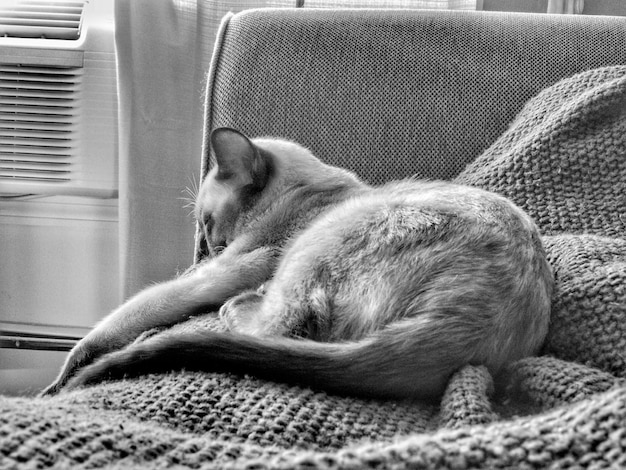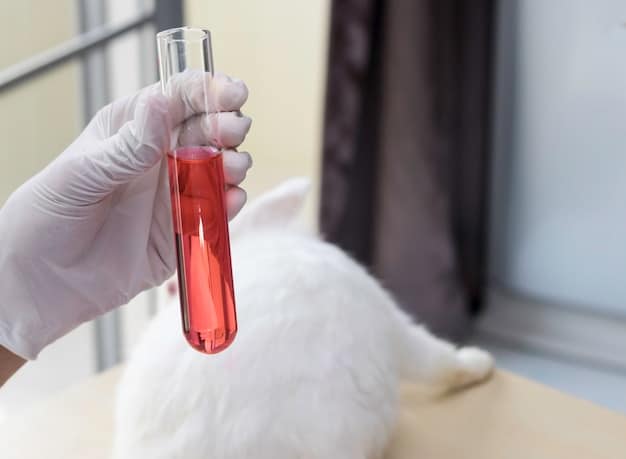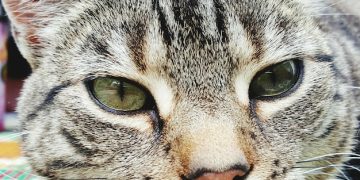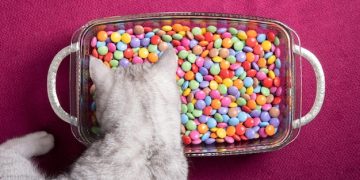Kidney Disease in Cats: Early Detection, Diet, and Quality of Life

Kidney disease in cats, also known as chronic renal failure, is a prevalent condition, especially in older cats, necessitating early detection through regular veterinary check-ups, implementing appropriate dietary management, and providing supportive care to enhance their quality of life.
Is your feline friend showing signs of illness? Kidney disease in cats is a common concern, particularly as they age. Early detection, proper dietary management, and supportive care can significantly improve your cat’s quality of life. Let’s explore how to recognize the signs, manage the diet, and provide the best possible care for your beloved pet.
Understanding Kidney Disease in Cats
Kidney disease, also known as chronic kidney disease (CKD) or chronic renal failure (CRF), is a progressive condition that affects the kidneys’ ability to filter waste products from the blood. This can lead to a buildup of toxins in the body, causing various health issues. Understanding how this disease manifests and progresses is the first step in providing proper care for your feline companion.
The kidneys play a vital role in maintaining your cat’s overall health. They filter waste from the bloodstream, regulate blood pressure, produce hormones, and maintain the balance of electrolytes and fluids. When the kidneys are damaged, these functions are compromised, leading to a range of symptoms.
What Causes Kidney Disease in Cats?
Several factors can contribute to the development of kidney disease in cats. Identifying potential causes can help in preventing or managing the condition effectively.
- Age-related degeneration: As cats age, their kidney function naturally declines.
- Genetic predisposition: Some breeds, such as Persians and Abyssinians, are more prone to kidney disease.
- High blood pressure: Chronic hypertension can damage the kidneys over time.
- Kidney infections: Infections can lead to inflammation and scarring of the kidney tissue.

The progression of kidney disease occurs in stages, each with varying degrees of severity. Early detection is crucial because intervention at an early stage can significantly slow the progression of the disease and improve the cat’s quality of life.
Recognizing Early Signs of Kidney Disease
Early detection of kidney disease in cats can be challenging, as the symptoms are often subtle and may be attributed to other age-related conditions. However, being vigilant and knowing what to look for can make a significant difference in early diagnosis and management.
Many cats do not show obvious symptoms until the disease is quite advanced, which is why regular veterinary check-ups are so important, especially for cats over the age of seven.
Common Symptoms to Watch For
Keep an eye out for these common symptoms, which may indicate early stages of kidney disease:
- Increased thirst and urination: This is often the first sign, as the kidneys lose their ability to concentrate urine.
- Weight loss: Despite having a normal appetite, your cat may start to lose weight.
- Lethargy: A decrease in energy levels and an overall lack of interest in play.
- Decreased appetite: Some cats may become picky eaters or completely lose their appetite.
If you notice any of these symptoms, it’s essential to consult your veterinarian immediately. They can perform diagnostic tests, such as blood and urine analysis, to determine if your cat has kidney disease and assess the severity of the condition.
The Importance of Veterinary Check-Ups
Regular veterinary check-ups are paramount for early detection and management of kidney disease in cats. These check-ups involve various diagnostic tests and examinations that can help identify kidney problems before they become severe.
During a routine check-up, your vet will perform a physical examination and may recommend blood and urine tests to evaluate kidney function. These tests provide valuable information about the health of your cat’s kidneys.
Key Tests for Kidney Disease
The following tests are commonly used to diagnose kidney disease in cats:
- Blood tests: Blood urea nitrogen (BUN) and creatinine levels are measured to assess kidney function. Elevated levels may indicate kidney damage.
- Urine tests: Urine specific gravity (USG) measures the concentration of urine. Dilute urine can be an early sign of kidney disease.
- SDMA test: Symmetric dimethylarginine (SDMA) is a more sensitive marker of kidney function and can detect kidney disease earlier than BUN and creatinine.
- Blood pressure measurement: High blood pressure can both cause and result from kidney disease, so monitoring it is crucial.

Regular monitoring is vital because kidney disease is progressive. Even with treatment, the condition may worsen over time. Periodic check-ups allow your veterinarian to adjust the treatment plan as needed to ensure your cat’s comfort and well-being.
Dietary Management for Cats with Kidney Disease
Dietary management plays a crucial role in slowing the progression of kidney disease and improving the quality of life for cats with this condition. Specific dietary adjustments can help reduce the workload on the kidneys and minimize the buildup of toxins in the body.
A well-planned diet for cats with kidney disease typically involves reducing protein, phosphorus, and sodium levels, while increasing omega-3 fatty acids and adding supplemental vitamin D. Always consult your veterinarian before making any significant changes to your cat’s diet.
Key Nutritional Considerations
When choosing food for a cat with kidney disease, consider the following nutritional factors:
- Lower protein: Reducing protein intake helps minimize the amount of waste products the kidneys need to filter.
- Lower phosphorus: Elevated phosphorus levels can worsen kidney damage.
- Lower sodium: Reducing sodium can help control blood pressure and fluid retention.
- Omega-3 fatty acids: These help reduce inflammation and support kidney function.
There are many commercially available kidney diets formulated to meet these needs. Your veterinarian can recommend the best diet based on your cat’s individual needs and preferences. Make any dietary changes gradually to avoid digestive upset.
Medications and Supportive Care
In addition to dietary management, medications and supportive care are often necessary to manage kidney disease in cats and alleviate symptoms. These treatments aim to address specific issues, such as high blood pressure, anemia, and nausea.
The specific medications and supportive care measures will depend on the severity of the kidney disease and the individual symptoms your cat is experiencing. It’s essential to work closely with your veterinarian to develop a comprehensive treatment plan.
Common Medications and Therapies
Some common medications and supportive care measures include:
- Phosphate binders: These medications help reduce the absorption of phosphorus from the diet.
- Antihypertensives: These medications help lower blood pressure, protecting the kidneys from further damage.
- Anti-nausea medications: These can help improve appetite and reduce vomiting.
- Fluid therapy: Subcutaneous or intravenous fluids can help maintain hydration and flush out toxins.
Creating a comfortable and stress-free environment is also an important aspect of supportive care. Provide a quiet, comfortable place for your cat to rest, and ensure they have easy access to fresh water and food. Regular grooming can also help improve their overall well-being.
Enhancing Quality of Life for Cats with Kidney Disease
Even though kidney disease is a chronic and progressive condition, there are many ways to improve and maintain a good quality of life for your cat. The goal is to manage the symptoms, slow the progression of the disease, and keep your cat as comfortable and happy as possible.
Providing a stable and loving environment, along with consistent medical care and dietary management, can make a significant difference in your cat’s overall quality of life. Regular monitoring and adjustments to the treatment plan are also essential.
Tips for Improving Your Cat’s Well-being
Consider these strategies to enhance your cat’s quality of life:
- Maintain hydration: Encourage your cat to drink water by providing fresh water in multiple locations and considering a water fountain.
- Provide a comfortable environment: Ensure your cat has a warm, soft bed and a quiet place to retreat.
- Minimize stress: Keep their environment calm and predictable, and avoid sudden changes.
- Offer gentle exercise: Encourage light activity to maintain muscle mass and mobility.
Remember, every cat is different, and what works for one may not work for another. Work closely with your veterinarian to tailor a care plan that meets your cat’s specific needs and preferences. With proper management and a lot of love, cats with kidney disease can still enjoy a happy and fulfilling life.
| Key Point | Brief Description |
|---|---|
| 🩺 Early Detection | Regular vet checkups and tests like BUN, creatinine, and SDMA are crucial for early diagnosis. |
| 🍲 Dietary Management | Lower protein, phosphorus, and sodium diets help manage the disease and reduce kidney workload. |
| 💊 Medication & Care | Phosphate binders, antihypertensives, and fluid therapy can alleviate symptoms and support kidney function. |
| 🏡 Quality of Life | Provide a comfy, stress-free environment, ensure hydration, and offer gentle exercise to improve well-being. |
Frequently Asked Questions
▼
Early signs include increased thirst and urination, weight loss, lethargy, and decreased appetite. These symptoms can be subtle, so regular veterinary check-ups are vital for early detection.
▼
Diagnosis typically involves blood tests (BUN, creatinine, SDMA) and urine tests (USG). Blood pressure measurement is also crucial. These tests help assess kidney function and detect abnormalities.
▼
Dietary changes include reducing protein, phosphorus, and sodium intake. Increasing omega-3 fatty acids is also beneficial. Consult your vet for the best diet plan.
▼
Yes, medications like phosphate binders and antihypertensives can help manage kidney disease. Anti-nausea meds and fluid therapy may also be prescribed to improve comfort.
▼
Ensure constant access to fresh water, provide a comfortable environment, minimize stress, and encourage gentle exercise. Regular vet visits and adjustments to the treatment plan are essential.
Conclusion
Managing kidney disease in cats requires a comprehensive approach that includes early detection, dietary adjustments, medication, and supportive care. By recognizing the early signs, working closely with your veterinarian, and providing a loving and comfortable environment, you can significantly improve your cat’s quality of life and help them live a happier, healthier life despite this chronic condition.





